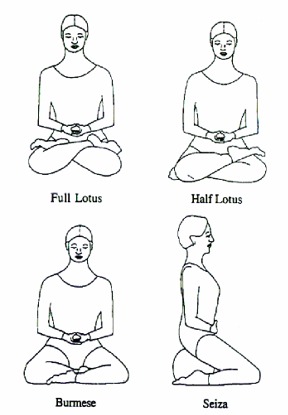
Zazen Instruction
PZC offers an introduction to Zen practice once a month at the Center and via Zoom.
If you would like to attend, email pzc@prairiezen.org
There is a video that we recommend viewing for those looking for an introduction to sitting meditation and
for anyone who would like a refresher. - To view the video, go HERE
We generally sit facing a wall. It’s a good idea to wear loose, comfortable clothing,
not to sit immediately after a meal, and to sit at a time when you would not normally feel sleepy.
1. Bow to your cushion, hands in gassho.
2. Sit on the forward third of your zafu and arrange your legs in a position you can stably sustain for the time you will be sitting. Your knees should be touching the floor with your weight on your “sit bones” on the cushion. If this is difficult, add another cushion under your buttocks. The point is to make a tripod with your weight centered over your knees (or feet) and buttocks. If you are physically unable to do this, kneel or sit on an upright chair, feet flat on the floor.
3. Center your spine by swaying from side to side in decreasing arcs until you come to a point of equilibrium.
4. Sit up straight, extend your spine, and align your head with your shoulders and navel. Imagine a plumb line hanging from the top of your skull down your backbone. Center your balance in your lower abdomen, relax your stomach, and keep your shoulders straight, but not rigid, to open your chest and sternum.
5. Keep your head level. Your ears should be parallel to your shoulders, your nose centered over your navel, and your chin tucked in slightly.
6. Lower your gaze to about three feet on the floor in front of you. Your eyes should be neither fully open nor fully closed. Don’t stare fixedly at one spot; just let your gaze relax and settle by itself, not looking at anything but seeing what is there.
7. Keep your mouth and teeth closed but relaxed. Place your tongue lightly against the roof of your mouth. This reduces the flow of saliva.
8. Hold your hands in the “Universal Mudra.” Place your right hand in your lap, palm up, against your abdomen about two fingers’ width below your navel. Rest your left hand, palm up on top of your right hand. Your thumb tips should be lightly touching to form an oval.
9. Breath naturally through your nose. Do not attempt to control your breathing.
10. Zen practice involves a balance of concentration and awareness. A certain degree of stillness is helpful. A good place to begin practice is to count your breaths. Breathe naturally through your nostrils and count one with the first exhalation. Allow the breath itself to count. The counting should be subvocal, not audible. Continue the count of one through the inhalation, counting two on the next exhalation. Continue counting with each exhalation until your reach ten. Then start back at one. If you lose count or notice yourself caught up in your thoughts and emotions, start over again at one. Don’t worry if you never seem to reach ten. Once the activity of your mind has settled, you may then try following your breath without counting.

(Chairs and benches are also available)
Sitting is allowing awareness of the bodily/sensory present moment as it is. When we notice that we are caught up in emotion/thought, we label the last thought that we noticed by adding “having a thought” and repeating it (e.g. “having a thought ‘I wonder why she said that?’”). We then return to allowing awareness, which might be a tightness in the chest, the sound of traffic, pain in the knees, or all of these and more. A useful analogy (but only an analogy) of awareness is, as water fills and adapts to the shape of a basin, awareness inhabits this bodily/sensory moment. Allowing awareness does not require us to do anything extra, except to be willing to be present as we are. This might be what we think of as heavy, weary, light, relaxed, boring, dull, painful, tight, etc. Our effort is in noticing getting caught up in emotion/thought, in labeling and making the effort to ‘return’ to experiencing.
It is important to sit regularly. Find a time when you can do it for at least ten minutes on your own each day. Don’t push yourself to sit an over-zealous amount of time - this may only discourage you. It is more important that your practice be regular. It may be helpful to use some sort of timer or alarm clock to time your sitting period. Glancing at a watch or clock periodically breaks your concentration.